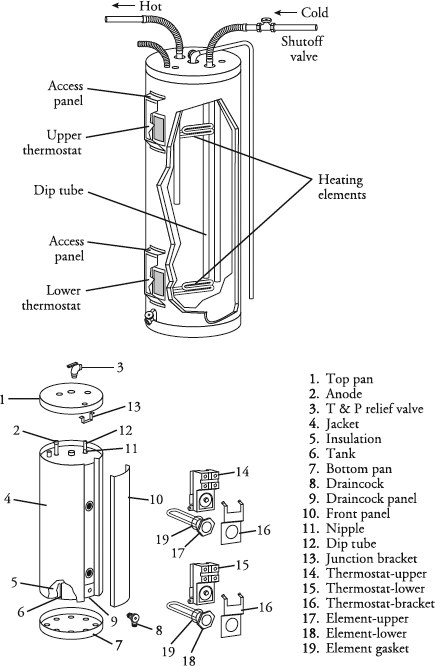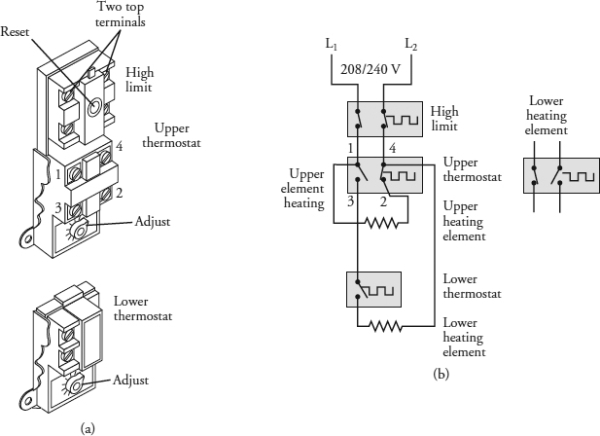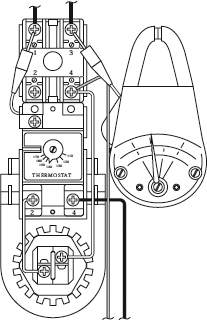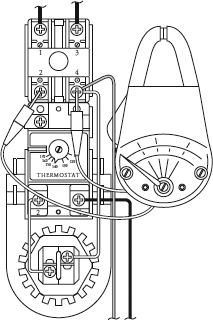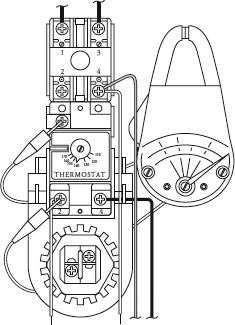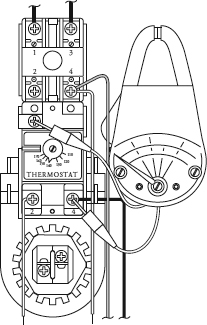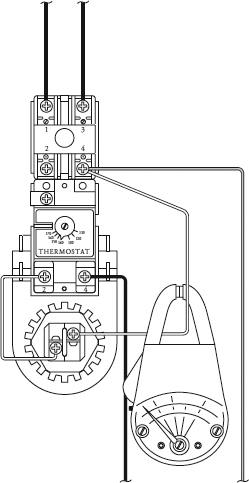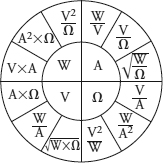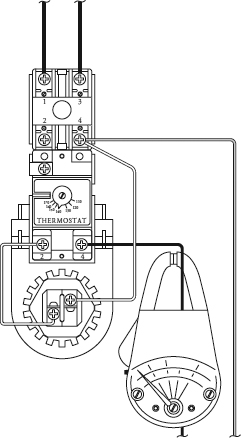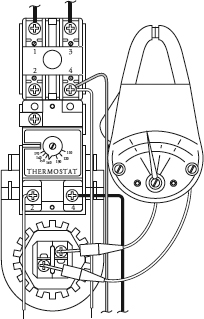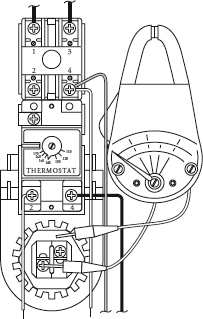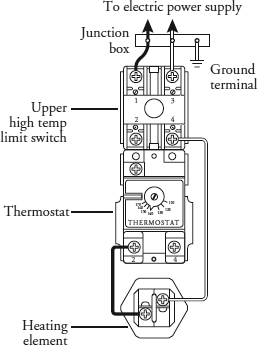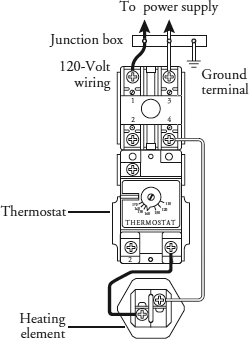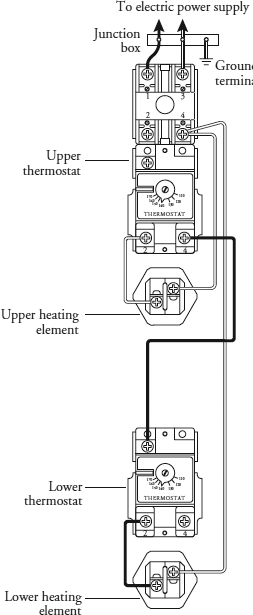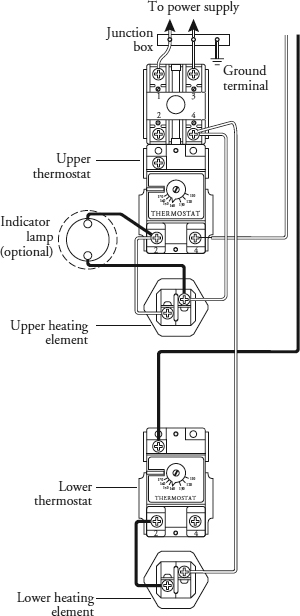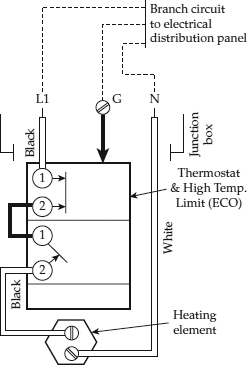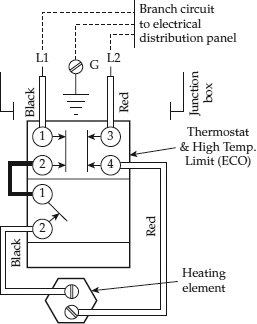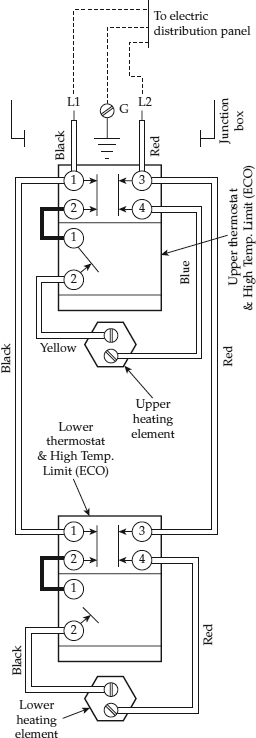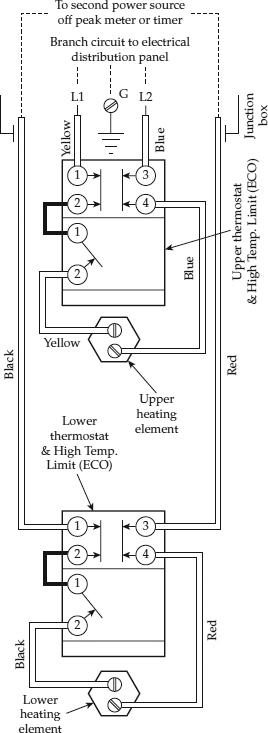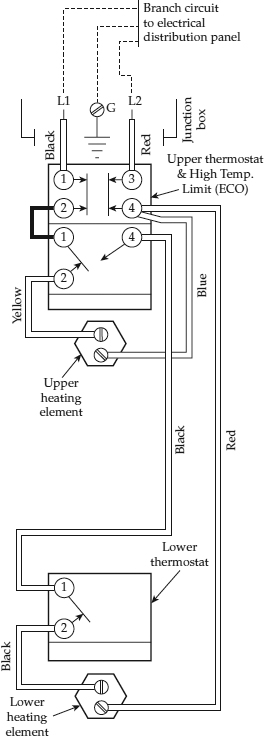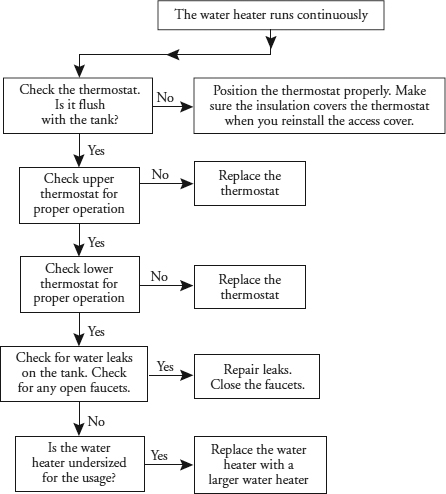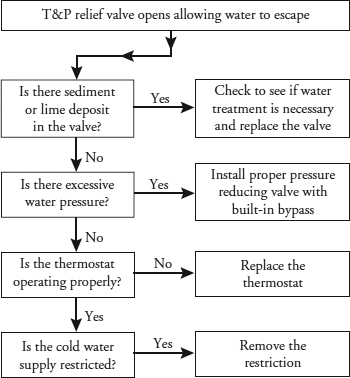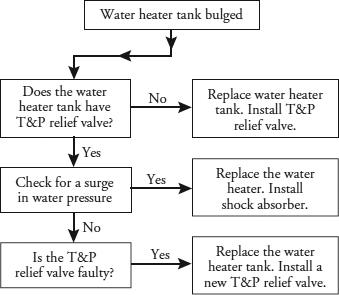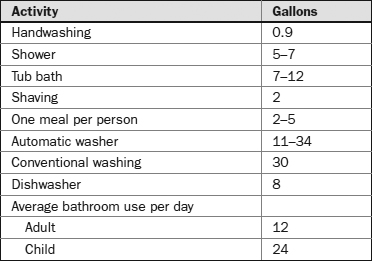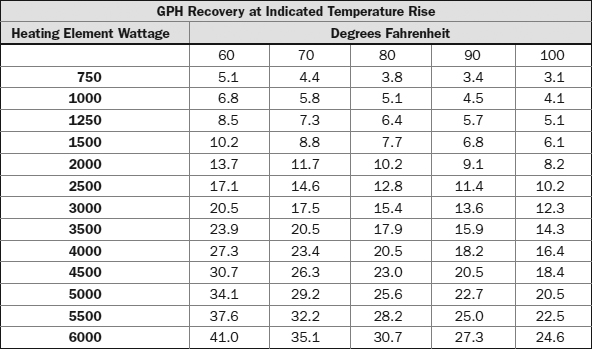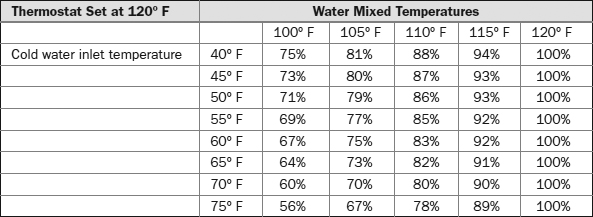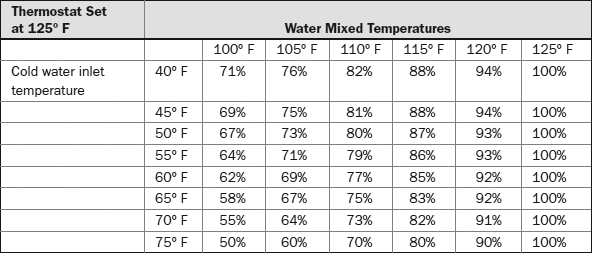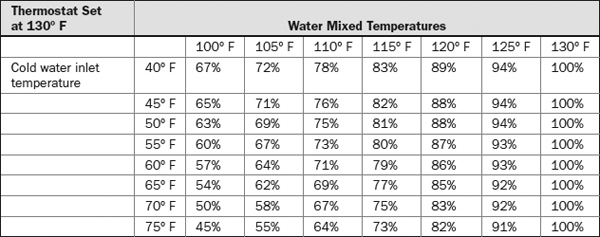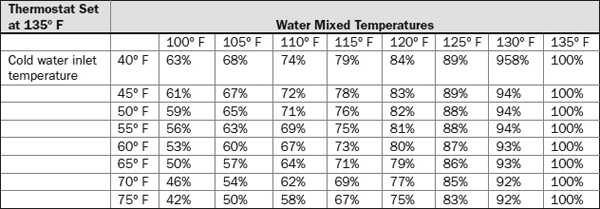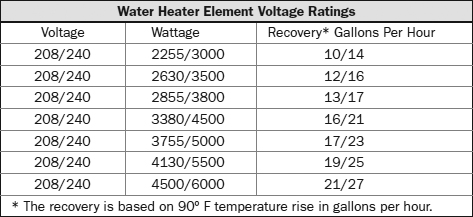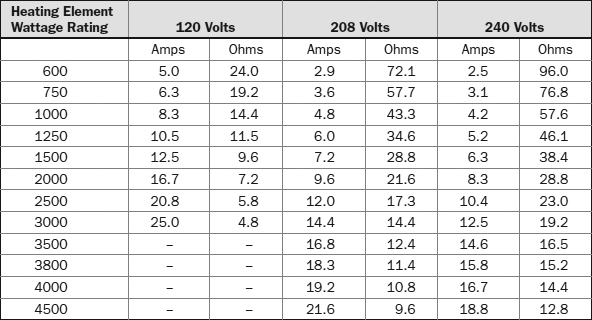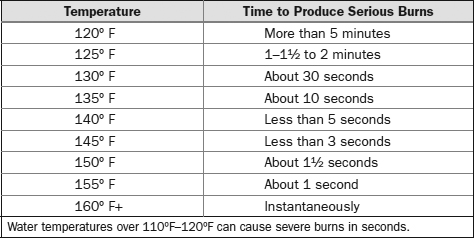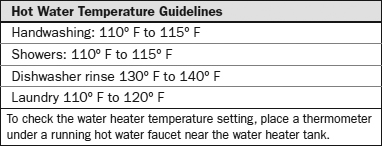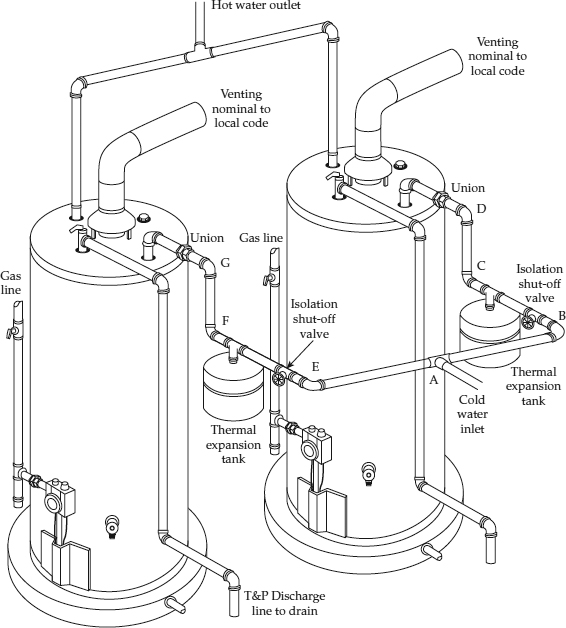16
CHAPTER
Electric Water Heaters
Electric water heaters are heat-producing appliances. They normally have two heating elements (Figure 16-1), with each element controlled by a thermostat. The thermostats are mounted on the outer wall of the water heater tank just above the elements, from where they sense the temperature of the water through the outer wall of the water heater tank. A temperature and pressure-relief valve, which is mounted on the outside of the tank, is a device applied to a water heater, which will open to pass water or steam if excessive pressure or temperature occurs in the water heater tank.
FIGURE 16-1 Exploded view of the electric water heater.
Electric water heaters are available in many different heights, widths, and capacities.
Principles of Operation
The water heater tank is full of water, the electricity is on, and the upper thermostat (see Figure 16-1) senses that the water is cold. This condition energizes the upper element. At the same time, the lower element is not activated. The upper heating element will heat approximately one-quarter of the tank’s capacity. When the temperature of the water reaches the thermostat setting, the upper thermostat will shut off. Then the lower thermostat becomes energized and heats the remainder of the water in the tank. When the temperature of the water reaches the thermostat setting, the lower thermostat will deactivate the lower heating element. The tank is now filled with hot water. As the consumer uses the hot water, it is drawn from the top of the tank and is replaced with cold water through a dip tube (see Figure 16-1) located near the bottom of the tank. When the lower thermostat senses the cold water, the thermostat activates the lower heating element, heating the water. Figure 16-2 identifies one of the many types of thermostats. The figure also shows a schematic drawing of the thermostat switch contacts.
FIGURE 16-2 (a) Typical upper and lower water heater thermostats. (b) Wiring schematic for upper and lower thermostats.
Safety First
Any person who cannot use basic tools or follow written instructions should not attempt to maintain or repair any electric water heaters. Any improper installation, preventive maintenance, or repairs could create a risk of personal injury or property damage.
If you do not fully understand the preventive maintenance or repair procedures in this chapter, or if you doubt your ability to complete the task on your electric water heater, please call your service manager.
These precautions should also be followed:
• Before checking the water heater, turn off the electricity.
• Never restore the electricity to the water heater if the tank is empty; do so only after it is full of water.
• Never remove the heating elements with the tank full of water.
• If a water heater needs to be replaced, it is strongly recommended that all electrical, plumbing, and placement of the tank be done by qualified personnel. Observe all local codes and ordinances for electrical, plumbing, and installation procedures.
Before continuing, take a moment to refresh your memory concerning the safety procedures in Chapter 2.
Electric Water Heaters in General
Much of the troubleshooting information in this chapter covers electric water heaters in general, rather than specific models, in order to present a broad overview of service techniques. The pictures and illustrations that are used in this chapter are for demonstration purposes only, to clarify the description of how to service these heaters. In no way do they reflect on a particular brand’s reliability.
Electric Water Heater Maintenance
Every so often, inspect the water heater tank for possible water leaks. Check the following:
• Check all pipe connections to the tank. If corroded, they must be repaired before there is serious water damage to the property.
• Check the temperature/pressure-relief valve. Is it leaking?
• Turn off the electricity; remove the access panels; and inspect the wiring, elements, and insulation for signs of water leakage. If water is leaking, the leak must be repaired or the unit must be replaced immediately.
Once a year, the water heater tank should be drained and flushed out. This will increase the life expectancy of the tank by removing any unwanted sediment. Before you begin draining the tank, turn off the electricity to the water heater. Then turn off the water supply to the tank. Connect a garden hose to the draincock, and open the valve. To increase the water flow draining out of the tank, open the hot water faucet. When you are ready to refill the tank, close the draincock and turn on the water supply to the water heater.
Leave the closest hot water faucet open during refilling; the air that is trapped in the tank will escape through the hot water faucet. When all of the air is out of the tank and water lines, turn off the hot water faucet. Go to all of the other hot water faucets and open them to remove air in the lines. Turn off all water faucets. Now you are ready to turn on the electricity to the water heater.
Step-by-Step Troubleshooting by Symptom Diagnosis
In the course of servicing an appliance, don’t tend to overlook the simple things that may be causing the problem. Step-by-step troubleshooting by symptom diagnosis is based upon diagnosing malfunctions, with their possible causes arranged into categories relating to the operation of the water heater. This section is intended only to serve as a checklist to aid you in diagnosing a problem. Look at the symptom that best describes the problem you are experiencing with the water heater, and then proceed to correct the problem.
No Hot Water
1. Do you have the correct voltage at the water heater?
2. Check for loose wiring.
3. Make sure that the reset button did not trip.
4. With the electricity off, check the thermostats for continuity.
5. With the electricity off, check the heating elements for continuity. Also check for a grounded heating element.
Not Enough Hot Water
1. Is the water heater undersized for the usage?
2. Check the lower heating element for continuity. Also check for a grounded heating element.
3. Check for leaking faucets and pipes.
4. Check to see if anyone is wasting water.
5. Drain the tank and remove the lower element. See if any sediment is in the bottom of the tank or around the heating element.
6. Is there any lime formation on the elements?
7. Are the thermostats operating properly? Run a cycle test.
8. Check the thermostat settings. Verify if they are set too low.
Water Too Hot
1. Check to see if the thermostat is snug against the tank.
2. Is the thermostat set too high?
3. Are the thermostats operating properly? Run the cycle test.
4. Check for a grounded element.
Water Heater Element Failure
1. Check for loose or burned wiring connections.
2. Check for the correct voltage to the elements.
3. Is the element shorted or grounded? Test the elements for continuity.
Discolored or Rusty Water
1. Drain the tank and remove the lower element. See if there is any sediment in the bottom of the tank.
2. Is the water supply to the water heater rusty in color?
3. Check the water for softness.
4. Check to see if there are excessive mineral deposits.
5. Inspect the anode rod to note its condition. If it has dissipated, replace the anode.
Repair Procedures
Each repair procedure is a complete inspection and repair process for a single water heater component, containing the information you need to test a component that may be faulty and to replace it, if necessary.
Any person who cannot use basic tools should not attempt to install, maintain, or repair any electric dryer. Any improper installation, preventative maintenance, or repairs will create a risk of personal injury, as well as property damage. Call the service manager if installation, preventative maintenance, or the repair procedure is not fully understood.
Upper Thermostat
The thermostat is a mechanical device that controls the flow of current to various parts of the water heater. The thermostat senses the heat from the tank wall. When the thermostat senses the heat, it can control the current that is sent to the upper element or to another part of the water heater tank. The upper thermostat is attached to the high-limit thermostat.
The typical complaints associated with the upper thermostat are:
• No hot water
• Burned wires
• Water heater runs continuously
• The fuse blows or the circuit breaker trips
To handle this problem, perform the following steps:
1. Verify the complaint. To verify the complaint, turn on the hot water. Does the water get hot?
2. Check for external factors. You must check for external factors not associated with the water heater. Is the water heater installed properly? Does the water heater have the correct voltage?
3. Disconnect the electricity. Before working on the water heater, disconnect the electricity. This can be done by pulling the plug out of the electrical outlet. Or disconnect the electricity at the fuse panel or at the circuit breaker panel. Many installations have a disconnect switch/breaker box near the water heater. Turn off the electricity. The voltage at the receptacle is between 198 volts and 264 volts during a load on the circuit (see Chapter 6).
4. Remove the access panel. To gain access to the upper thermostat, the access panel must be removed (see Figure 16-1). The access panel is held on with two screws on most models. Peel back the insulation and then remove the thermostat’s protective cover.
5. Test the thermostat. To test the upper thermostat, use your voltmeter. Set the range on the 300-volt scale. Touch the probes to terminals 1 and 3 above the reset button (Figure 16-3). Turn on the electricity. If the meter reads no voltage, have the customer call an electrician to find out where the power failure is. If the meter reads the proper rated voltage, as stated on the name plate, the electricity is okay. Next, touch the probes to terminals 2 and 4 below the reset button (Figure 16-4). If the meter reads the proper rated voltage, the electricity is okay. If the meter reading is “0” volts, press the reset button on the thermostat. If there is still no voltage reading on the meter scale, either the water temperature in the tank is too hot or the thermostat is inoperative. At this stage, turn off the electricity to the tank again. Remove the wires from the upper heating element (Figure 16-5). Be absolutely sure that the electricity is off before any further tests are made using your ohmmeter.
FIGURE 16-3 Place the voltmeter probes on terminals 1 and 3 to check the voltage.
FIGURE 16-4 Place the voltmeter probes on terminals 2 and 4 to check the voltage.
FIGURE 16-5 Remove the wires from the element. Place the ohmmeter probes on terminals 1 and 2. When the thermostat is calling for the element to come on, the ohmmeter scale will read continuity.
Use your ohmmeter to test terminals 1 and 2 on the upper thermostat (see Figure 16-5). If the thermostat is calling for heat, the ohmmeter needle will swing to the right, showing continuity. Now touch the probes to terminals 1 and 4 on the thermostat (Figure 16-6). If the water in the tank is cold, you will not get a reading on the ohmmeter scale. If the water in the tank is hot, as called for by the thermostat, the needle will swing to the right, thus showing continuity.
FIGURE 16-6 Place the ohmmeter probes on terminals 1 and 4. If water in the tank is cold, the ohmmeter scale will read no continuity.
6. Cycle the upper thermostat. Reconnect the wires to the heating element. Turn on the electricity to the tank. Take your ammeter and clamp the jaws around the wire that goes from terminal 4 to the upper element (Figure 16-7). With cold water in the tank and the thermostat calling for heat, you should get a reading on the meter in amps.
FIGURE 16-7 The ammeter jaws encircling the terminal 4 wire go to the element.
The reading you get will depend on the rating (in watts) of the heating element, divided by the voltage supplied (see the formula in Figure 16-8). After the temperature is reached, the needle on the ammeter scale will read “0.”
Conversion chart for determining amperes, ohms, volts, or watts (Amperes = A, Ohms = Ω, Volts = V, Watts = W)
FIGURE 16-8 Ohm’s Law Equation Wheel: The conversion chart for determining amperes, ohms, volts, or watts.
Next, place the ammeter jaws on the terminal 4 wire that goes from the upper thermostat (just below the temperature gauge setting) to the lower element (Figure 16-9). The ammeter should show a reading, indicating that the lower element is working.
FIGURE 16-9 Place the ammeter jaws around terminal 4. The ammeter reading is 0.
7. Replace the upper thermostat. Turn off the electricity to the water heater. To replace the upper thermostat, remove all of the wires from the thermostat. Be sure that you mark the wires so that you can replace them exactly the way you took them off. Next, pry back the thermostat retaining bracket with your fingers far enough to slide the thermostat up and out; remove the thermostat.
NOTE Do not pry back too much on the retaining bracket. It might break and the water heater tank will have to be replaced. To install the new thermostat, just reverse the disassembly procedure, and reassemble. Be sure that the thermostat is snugly mounted against the tank so that it can sense the temperature better. Reinstall the protective cover and insulation.
8. Test the new upper thermostat. After you have completed the new installation, turn on the electricity to the water heater. Repeat this testing process as described, and verify that the new unit is working correctly.
Lower Thermostat
The lower thermostat monitors the water temperature in the lower section of the water heater tank. The lower thermostat turns on and off the lower element.
Testing the lower thermostat is similar to testing the upper thermostat, with the following exception. With the wires removed from the element, place the ohmmeter’s probes on each terminal. Take a screwdriver, place it on the set screw of the thermostat, and turn it clockwise. The needle on your ohmmeter will swing to the right, indicating that there is continuity. If the needle does not move, the thermostat needs to be replaced. Replace this thermostat as per the upper thermostat replacement procedure previously described. Then test the thermostat by placing the jaws of the ammeter around the wire that connects to the lower thermostat. Check to be sure that the thermostat cycles on and off.
Heating Element
The heating element is made from a nichrome filament, surrounded by magnesium oxide powder for heat transfer, and is encased in an immersion-type casing. This type of heating element cannot be turned on unless there is water present in the water heater tank to submerge the heating element.
The typical complaints associated with the heating element are:
• No hot water
• Burned wires
• The fuse blows or the circuit breaker trips
To handle this problem, perform the following steps:
1. Verify the complaint. To verify the complaint, turn on the hot water. Does the water get hot?
2. Check for external factors. You must check for external factors not associated with the water heater. Is the water heater installed properly? Does the water heater have the correct voltage?
3. Disconnect the electricity. Before working on the water heater, disconnect the electricity. This can be done by pulling the plug out of the electrical outlet. Or disconnect the electricity at the fuse panel, the circuit breaker panel, or the disconnect switch. Turn off the electricity. The voltage at the receptacle is between 198 volts and 264 volts during a load on the circuit (see Chapter 6).
4. Remove the access panel. In order to gain access to the heating element, the access panel must be removed (see Figure 16-1). The access panel is held on with two screws on most models. Peel back the insulation and then remove the wires from the heating element.
5. Test the heating element. Use the ohmmeter to test the heating element. Set the range to R × 1. Touch the probes to the element screws (Figure 16-10). If the element is good, the ohmmeter scale will show continuity. If the element is bad, the ohmmeter needle will not move, showing an open element. Now, set the ohmmeter on R × 100. Take one probe and place it on either terminal of the element. Take the other probe and touch the element head (Figure 16-11) or the tank. If you get any reading, the element is grounded and should be replaced. Repeat this procedure for the other terminal on the element. Both terminals must be measured for grounding.
FIGURE 16-10 Testing the heater element. Place the ohmmeter probes on the screw terminals of the element.
FIGURE 16-11 Testing the heater element for ground.
6. Remove the element. Turn off the electricity to the water heater. Next, turn off the water supply. Connect a garden hose to the draincock, and open the draincock. At the same time, open a nearby faucet to allow the water to drain faster. After the tank is empty, disconnect the wires from the element and remove it. The screw-in type can be removed by using a 1½-inch socket or a 3/8-inch socket for the four bolt–type elements.
7. Install the new element. To install the new element, just reverse the disassembly procedure, and reassemble. When installing the new element, always replace the gasket. Before you insert the new element into the tank, clean the flange of debris.
8. Test the new element. When you are done installing the replacement element, close the draincock, and open the water supply. Close the nearby faucet after all of the air in the tank has dissipated. Next, check for water leaks. Turn on the electricity to the water heater. Use the ammeter to check the element. The ammeter should show a reading.
Diagnostic Charts
The following diagnostic flowcharts, wiring diagrams, and tables will help you to pinpoint the likely causes of the problem (Figures 16-12 through 16-26 and Tables 16-1 through 16-12). Figures 16-27 and 16-28 illustrate a typical water heater installation for a series and parallel tanks.
FIGURE 16-12 Pictorial wiring diagram for a standard two-wire 208/240 volt circuit, single element.
FIGURE 16-13 Pictorial wiring diagram for a standard two-wire 208/120 volt circuit, single element.
FIGURE 16-14 Pictorial wiring diagram for a standard two-wire interlocking 208/240/277 volt circuit, double element.
FIGURE 16-15 Pictorial wiring diagram for a four-wire, off-peak double element, nonsimultaneous operation.
FIGURE 16-16 120-volt single-element water heater wiring diagram.
FIGURE 16-17 240-volt single-element water heater wiring diagram.
FIGURE 16-18 Double-element simultaneous operation water heater wiring diagram.
FIGURE 16-19 Double-element simultaneous operation with four-wire outlet water heater wiring diagram.
FIGURE 16-20 Double-element nonsimultaneous water heater wiring diagram.
FIGURE 16-21 Double-element nonsimultaneous with four-wire outlet water heater wiring diagram.
FIGURE 16-22 Double-element nonsimultaneous with three-wire outlet water heater wiring diagram.
FIGURE 16-23 Water heater flowchart: Circuit breaker out or fuse blown.
FIGURE 16-24 Water heater flowchart: Water heater runs continuously.
FIGURE 16-25 Water heater flowchart: Relief valve opens.
FIGURE 16-26 Water heater flowchart: Water heater tank bulged.
TABLE 16-1 Typical Hot Water Usage Chart
TABLE 16-2 Electric Water Heater Recovery Chart
Example: If the water heater thermostat is set on 120 degrees Fahrenheit and the cold water inlet temperature is 50 degrees Fahrenheit and the bath water is at 110 degrees Fahrenheit, the water mixture would be 86 percent hot water and 14 percent cold water.
TABLE 16-3 The Percentage of Hot and Cold Water Mixture
TABLE 16-4 The Percentage of Hot and Cold Water Mixture with Water Heater Set on 125 Degrees Fahrenheit
TABLE 16-5 The Percentage of Hot and Cold Water Mixture with Water Heater Set on 130 Degrees Fahrenheit
TABLE 16-6 The Percentage of Hot and Cold Water Mixture with Water Heater Set on 135 Degrees Fahrenheit
TABLE 16-7 The Percentage of Hot and Cold Water Mixture with Water Heater Set on 140 Degrees Fahrenheit
TABLE 16-8 Most Water Heater Elements Have a Dual Rating for Single Phase 208 and 240 Volt Operation
TABLE 16-9 Fuse or Circuit Breaker and Wire Size for Electric Water Heater
TABLE 16-10 Voltage, Wattage, Ohms, and Amperage of Heating Elements
TABLE 16-11 Always Mix the Hot and Cold Water when Bathing to Avoid Possible Burns or Scalding
TABLE 16-12 Water Temperature Guideline for Common Activities Using Hot Water
FIGURE 16-27 A typical series water heater installation. This type of installation is used for high-demand households. If the existing single-tank installation cannot handle the demand, then another tank can be added.
FIGURE 16-28 A typical parallel water heater installation. This type of installation is used for high demand for large quantities of hot water over a short period of time.
Help on the Internet
To obtain additional technical help or information on selecting an electric water heater, you can go to the following websites:
